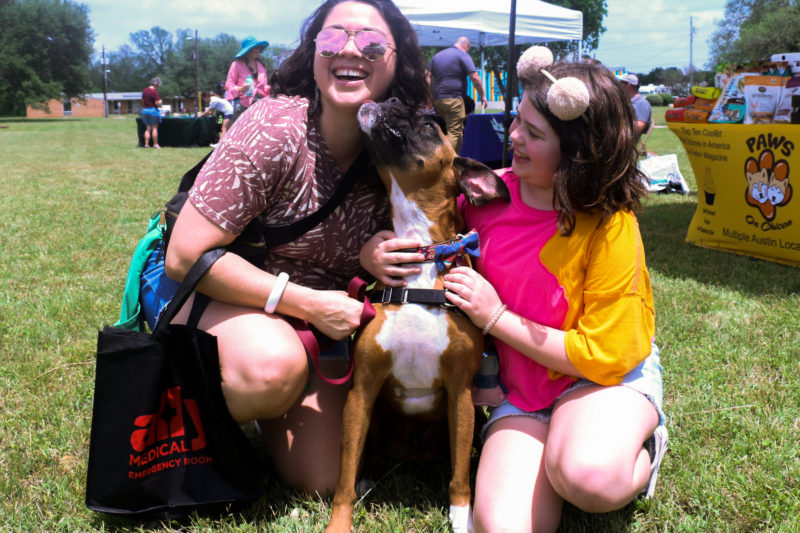Austinites Dance With Dogs To Encourage Adoptions From Animal Center
By Veronica Apodaca
Reporting Texas

Community members join Austin Animal Center volunteers and staff to perform The Insta-Dog Dance with their dogs during the Dances for Dogs and People Who Walk Them event on the front lawn of the Austin Animal Center in Austin on April 23, 2022. Participants danced and performed tricks with their dogs to bring awareness about the center’s work and to encourage adoptions. Clarissa Rodríguez Abrego/ Reporting Texas
Austin Animal Center veterinarian Dr. Rachel Hays trotted with her dog, The Raccoon, a trim, medium-sized dog with dark spots around her eyes, in a circle as jazz music played. Every few steps Hays paused and encouraged the dog to do a trick, such as scooting backward in time to the music.
About 200 visitors joined Hays at the Austin Animal Center Saturday for Dances for Dogs and People Who Walk Them, an event held in cooperation with Forklift Danceworks.
Animal Center employees and volunteers, along with their dogs, performed dances choreographed by Forklift founder and artistic director Allison Orr. Some, like Hayes’ dog, were happy to perform tricks and dances with their owners, while others simply wanted to be carried through the dances.
The event included shelter tours that allowed visitors to see dogs available for adoption. With waived adoption fees and free microchips at the event, there was also the opportunity to take home a dog right away. Animal Center employees also encouraged guests to return and adopt a dog.
“It’s really celebrating dogs and people’s relationships with their dogs and with their pets more generally, and I think for many people that’s been an important part of the last two years,” said Gretchen LaMotte, Forklift’s choreographer and program manager, who directed the show.
There has been an increase in owners wanting to get rid of their dogs in the last year, Mark Sloat, an Austin Animal Center program manager, said. In the Austin area that means more dogs are being brought to the center, he added.
The Austin Animal Center, the largest no-kill animal shelter in the nation, shelters more that 18,000 animals each year and has redoubled its efforts to encourage owners to keep dogs rather than giving them to the center.
“We’re going out to share information, to listen and then to try to help people be successful. Maybe they need fencing, maybe they need spay-neuter help, maybe they need microchips, maybe they need all those things. But they probably don’t need a ticket and they probably don’t want us to take their dog,” Sloat said.

Meg Mascareñas and her daughter Lillian share a moment with their dog, Lupe, during the Dances for Dogs and People Who Walk Them event outside the Austin Animal Center. Clarissa Rodríguez Abrego/ Reporting Texas
When the pandemic began, the center, like many businesses, closed its doors to the public — except for emergency cases, such as injured or overly aggressive dogs, no animals came into the center for several months.
Animal Center employees began meeting with members of the public over telephone and Skype rather than in person, Sloat said.
With the reopening of the center in May 2021, employees hoped intake numbers would stay low to prevent overcrowding. Numbers are moving back to where they were pre-pandemic, when the shelter was over capacity for large and medium sized dogs.
Dogs found wandering outside without an owner are often immediately brought to the center by well-meaning residents, Kelsey Cler, marketing and communications manager for the center, said. But there are better ways to handle such situations, she added.
Cler encouraged residents to check Nextdoor or Facebook to find stray dogs’ owners, who might be in the neighborhood where the dog was found. “We serve Travis County, which is 900 square miles. So we might get a stray dog from Jonestown, that’s 30 miles away, and their owner might not think to look at the shelter for their dog.”
“We are trying to still find that middle ground where we’re still providing needed services to the community, we’re still helping animals that need us, but we’re asking the community to help a little bit more as well, Cler said.
The center often runs low on space for large and medium sized dogs, Rebekha Monti, center program manager said.
“Small dogs are extremely popular at our shelter. They go very, very fast — also, puppies, kittens. Anything that is going to be two years and up that is a larger to medium sized dog and has any type of (pitbull) in it is probably going to get stuck for a little bit,” Monti said.
LaMotte hoped event attendees would stay involved with the center.
“We’re certainly hoping that folks learn more about how to get involved with the shelter, how to support the work they do, how to also just really be active members of our community, and take care of animals and people as a community,” LaMotte said.

Participants in the Dances for Dogs and People Who Walk Them event walk on the front lawn of the Austin Animal Center. They performed The Insta-Dog Dance – a routine led by Allison Orr, Forklift Danceworks founder and artistic director. Clarissa Rodríguez Abrego/ Reporting Texas